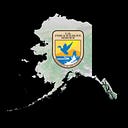Arctic Refuge Virtual Bird Fest
Songs From On High: Peregrine Falcons
From river bluffs in America’s northernmost wildlife refuge to the city skyscrapers of New York City and beyond, the world’s fastest bird calls every continent except Antarctica home.
Alaska is home to all three of subspecies of peregrine falcons found in North America: the Peale’s, Arctic (tundra), and American. Some winter in South America while others stay in Alaska year-round.
The largest and darkest-plumed of the peregrines, Peale’s (Falco peregrinus pealei), are a maritime subspecies found along Alaska’s coast from Southeast Alaska to the Aleutians. Peale’s tend to stick to their territory and overwinter in Alaska, but will leave if food becomes scarce. The Arctic (F. peregrinus tundriu) and American (F. peregrinus anatum) subspecies migrate.
Most peregrines from northern Alaska, Canada, and Greenland migrate to Central and South America in the fall — sometimes all the way to Columbia, Chile, and Argentina — hunting along the way. They return to interior Alaska in mid-late April and can be seen soaring the thermals above the Alaska Range on their way north to their breeding territories (most return to the same river bluffs and cliffs to the same nest sites).
Last century, the migrating varieties were hit hard by DDT exposure in the lower 48 states and elsewhere along their migration path. Both the American and Arctic subspecies declined precipitously mid century and were both listed as Endangered under the Endangered Species Conservation Act of 1969 (the law preceding the Endangered Species Act of 1973). Thanks to ESA recovery efforts and reduced use of DDT throughout their range, both subspecies have recovered.
kak, creak, wail and chitter
Adult peregrines have several vocalization types with different meanings for different situations. So look to the sky, and to the ledge, for context clues.
Wailing. Along continuous call used in a variety of situations (antagonistic, parental, looking for a mate, etc.). Sounds like ghiii-ghiii-ghiii-ghiii.
Creaking. Peregrine-to-peregrine vocalization used in courting rituals and other situations. Sounds like iiichep/ee-chup.
Kakking. Alert call used against non-peregrine enemies, or to recruit other peregrines for defense of a nest. Sounds like kak kak kak.
Chitter. A close contact sound between mates. A rapid chi chi chi.
In Alaska’s Yukon-Kuskokwim Delta, the peregrine is known as qiirayuli. In Yupik, this means “the one who calls qee qee qee qee” when disturbed. In higher latitudes, other names include, but aren’t limited to: Ch’akwaii chan ts’ik (Gwich’in) and kirgavich kiriat (Northwest Alaska Inupiaq).
Arctic Refuge Virtual Bird Festival:
https://www.arcticbirdfest.com/ #ArcticBirdFest
Katrina Liebich is based in Anchorage, Alaska.
In Alaska we are shared stewards of world renowned natural resources and our nation’s last true wild places. Our hope is that each generation has the opportunity to live with, live from, discover and enjoy the wildness of this awe-inspiring land and the people who love and depend on it.
